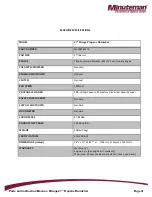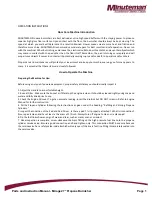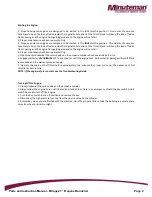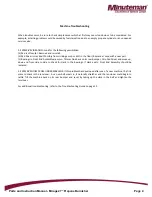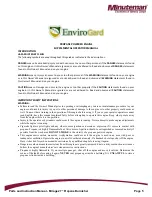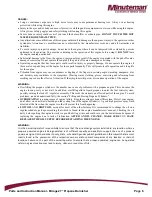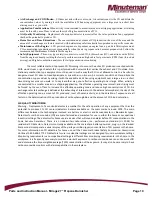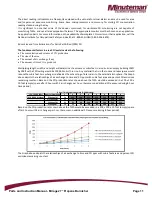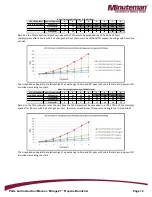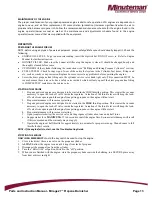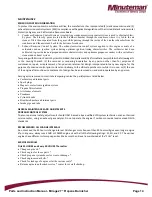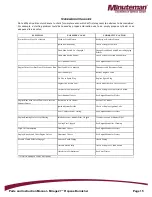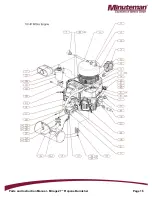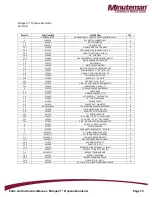
Parts and Instruction Manual -
Mirage 27” Propane Burnisher
Page 11
The direct reading instruments are frequently equipped with audio and/or visual alarms and may be used for area
and/or personal exposure monitoring. Some have microprocessors and memory for storing CO concentration
readings taken during the day.
It is significant to note that some of the devices mentioned for workplace CO monitoring are not capable of
monitoring TWAs, and not all are equipped with alarms. The appropriate monitor must be chosen on an application-
by-application basis. For more information on the availability of workplace CO monitors or their application, call the
National Institute for Occupational Safety and Health at 1-800-35-NIOSH (1-800-356-4674).
Room Size and Time Estimations for Parts Per Million (PPM) CO
The fundamental factors in area CO levels involve the following:
The concentration and volume of CO production
The size of the area
The amount of air exchange if any
The amount of time CO is produced
Multiplying length, width, and height will determine the volume or cubic feet in a room. So an empty building 100ft
by 100ft with a 10ft ceiling would be 100,000 cubic ft. in size. Any material that is in the room and takes space would
reduce the cubic feet. Air exchange is defined as the exhausting of internal air to the external atmosphere. The Graph
above depicts the relationships of air exchange to time and CO ppm with cubic feet area and percent CO emissions
remaining constant. Based on the CO production rates shown above the TWA would be exceeded in a 100 x 100 x
10 foot (empty) space after 3 hours with 2 air changes per hour. (Assumes no additional CO exposure during 8 hour
time period)
Based on the CO production rates sown above the TWA would be exceeded in a 100 x 100 x 10 foot (empty) space
after 3 hours with 2 air changes per hour. (Assumes no additional CO exposure during 8 hour period)
The Graph above depicts the relationships of air exchange to time and CO ppm with cubic feet area and percent CO
emissions remaining constant.
1.5% CO 100,000cf
Hours of Operation
1
2
3
4
5
6
7
8
TWA (OSHA Method)
0 Change/hr
34
103
206
343
514
719
959
1232
1/2 Change/hr
27
70
124
183
246
311
378
445
1 Change/hr
22
51
34
118
152
186
220
255
2 change/hr
15
32
49
66
83
100
117
135
8 Hour Time Weighted Average (OSHA Method)
Summary of Contents for Mirage 27"
Page 1: ...Parts and Instruction Manual Mirage 27 Propane Burnisher ...
Page 23: ...Parts and Instruction Manual Mirage 27 Propane Burnisher Page 16 ...
Page 25: ...Parts and Instruction Manual Mirage 27 Propane Burnisher Page 18 ...
Page 28: ...Parts and Instruction Manual Mirage 27 Propane Burnisher Page 21 ...
Page 29: ...Parts and Instruction Manual Mirage 27 Propane Burnisher Page 22 Notes ...

